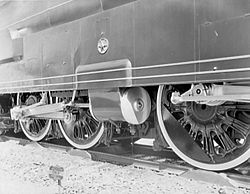
Duplex locomotive
Encyclopedia

Steam locomotive
A steam locomotive is a railway locomotive that produces its power through a steam engine. These locomotives are fueled by burning some combustible material, usually coal, wood or oil, to produce steam in a boiler, which drives the steam engine...
that divides the driving force
Divided drive (locomotive)
A divided drive locomotive is a steam locomotive that divides the driving force on its wheels by using different cylinders to power different pairs of driving wheels in order to give better weight distribution and reduce "hammer blow" which can be damaging to the track, or else to enable the wider...
on its wheels by using two pairs of cylinders rigidly mounted to a single locomotive frame
Locomotive frame
A locomotive frame is the structure that forms the backbone of the railway locomotive, giving it strength and supporting the superstructure elements such as a cab, boiler or bodywork. The vast majority of locomotives have had a frame structure of some kind...
; it is not an articulated locomotive
Articulated locomotive
Articulated locomotive usually means a steam locomotive with one or more engine units which can move independent of the main frame. This is done to allow a longer locomotive to negotiate tighter curves...
. The concept was first used in France in 1863, but was particularly developed in the early 1930s by the Baldwin Locomotive Works
Baldwin Locomotive Works
The Baldwin Locomotive Works was an American builder of railroad locomotives. It was located in Philadelphia, Pennsylvania, originally, and later in nearby Eddystone, Pennsylvania. Although the company was very successful as a producer of steam locomotives, its transition to the production of...
, the largest commercial builder of steam locomotives in North America
North America
North America is a continent wholly within the Northern Hemisphere and almost wholly within the Western Hemisphere. It is also considered a northern subcontinent of the Americas...
, under the supervision of its then chief engineer, Ralph P. Johnson.
Prior to this, the term duplex locomotive was sometimes applied to articulated locomotive
Articulated locomotive
Articulated locomotive usually means a steam locomotive with one or more engine units which can move independent of the main frame. This is done to allow a longer locomotive to negotiate tighter curves...
s in general.
Drawbacks of the 2-cylinder locomotive
While the side rods (UK: coupling rods) of a locomotive can be completely balanced by weights on the driving wheelDriving wheel
On a steam locomotive, a driving wheel is a powered wheel which is driven by the locomotive's pistons...
s since their motion is completely rotational, the reciprocating motions of the pistons, piston rod
Piston rod
In a piston engine, a piston rod joins a piston to a connecting rod.Many internal combustion engines, and in particular all current automobile engines, do not have true piston rods, and the term piston rod is often used as a synonym for connecting rod in the context of these engines.All engines...
s, main rods and valve gear
Valve gear
The valve gear of a steam engine is the mechanism that operates the inlet and exhaust valves to admit steam into the cylinder and allow exhaust steam to escape, respectively, at the correct points in the cycle...
cannot be balanced in this way. A two-cylinder locomotive has its two cranks "quartered" — set at 90° apart — so that the four power strokes of the double-acting pistons are evenly distributed around the cycle and there are no points at which both cylinders are at top or bottom dead center simultaneously. A four-cylinder locomotive can be completely balanced in the longitudinal and vertical axes, although there are some rocking and twisting motions which can be dealt with in the locomotive's suspension and centering; a three-cylinder locomotive can also be better balanced, but a two-cylinder locomotive only balanced for rotation will surge fore and aft. Additional balance weight — "overbalance" — can be added to damp this, but at the cost of adding vertical forces, which are known technically as "dynamic augment" and colloquially as "hammer blow
Hammer blow
Hammer blow, in rail terminology, refers to the vertical forces transferred to the track by the driving wheels of a steam locomotive and some diesel locomotives. The largest proportion of this is due to the unbalanced reciprocating motion, although the piston thrusts also contribute a portion to it...
". This can be extremely damaging to the track, and in extreme cases can actually cause the driving wheels to leave the track entirely. The heavier the reciprocating machinery, the greater these forces are, and the greater a problem this becomes.
The duplex solution
In Europe this problem was often overcome by dividing the driveDivided drive (locomotive)
A divided drive locomotive is a steam locomotive that divides the driving force on its wheels by using different cylinders to power different pairs of driving wheels in order to give better weight distribution and reduce "hammer blow" which can be damaging to the track, or else to enable the wider...
between inside and outside cylinders, or else by using Articulated locomotive
Articulated locomotive
Articulated locomotive usually means a steam locomotive with one or more engine units which can move independent of the main frame. This is done to allow a longer locomotive to negotiate tighter curves...
s, although at the time it was not believed possible to run one stably at greater than 50 mph. American railroads proved to be unwilling to use locomotives with inside cylinders, so the problem of balance could not be solved by adding more cylinders per coupled wheel set. As locomotives got larger and more powerful, their reciprocating machinery had to get stronger and thus heavier, and thus the problems posed by imbalance and hammer blow became more severe. Speed also played a factor, since the forces became greater and more destructive at higher wheel speeds. Ralph P. Johnson felt that the growing size and piston thrusts of existing express passenger locomotives could not be sustained with the by-then conventional 4-8-4
4-8-4
Under the Whyte notation classification of steam locomotives, 4-8-4 represents the wheel arrangement of four leading wheels on two axles , eight powered and coupled driving wheels on four axles, and four trailing wheels on two axles .Other equivalent classifications are:UIC classification: 2D2...
2-cylinder layout. In addition, he became convinced that a single pair of cylinders with conventional valve gear and piston valves was approaching the limits in terms of steam flow.
The earliest attempt at duplex locomotive was an 0-6-6-0
0-6-6-0
In Whyte notation, a 0-6-6-0 is a railroad steam locomotive that has two articulated sections, each with six coupled driving wheels, without any leading wheels or trailing wheels.-Equivalent classifications:Other equivalent classifications are:...
tank locomotive
Tank locomotive
A tank locomotive or tank engine is a steam locomotive that carries its water in one or more on-board water tanks, instead of pulling it behind it in a tender. It will most likely also have some kind of bunker to hold the fuel. There are several different types of tank locomotive dependent upon...
designed by Jules Petiet
Jules Petiet
Jules Petiet was a French mechanical engineer who worked on the early development of the French railroad network. He was a designer of locomotives, as well as the chief executive of the Chemins de Fer du Nord railroad company...
in 1863 for the French Northern Railway
Chemin de Fer du Nord
Chemin de Fer du Nord , often referred to simply as the Nord company, was a rail transport company created in September 1845, in Paris, France. It was owned by among others de Rothschild Frères of France, N M Rothschild & Sons of London, England, Hottinger, Laffitte and Blount...
, but the idea was not perpetuated. However, the innovation of more rigid hinges that permitted only horizontal swinging movements and not twisting or vertical movement was from ALCO
American Locomotive Company
The American Locomotive Company, often shortened to ALCO or Alco , was a builder of railroad locomotives in the United States.-Early history:...
, and not seen until 1936's Union Pacific Challenger
Union Pacific Challenger
Built between 1936 and 1943, the Challengers were nearly 122 feet long and weighed more than one million pounds. Articulated like their big brother, the Union Pacific Big Boy, the Challengers had a 4-6-6-4 wheel arrangement...
.
Instead came the idea of having multiple groups of cylinders and driven wheels mounted in one rigid frame. A "duplex" version of a 4-8-4 would be a 4-4-4-4
4-4-4-4
A 4-4-4-4 steam locomotive, in the Whyte notation for describing locomotive wheel arrangements, has a four-wheel leading truck, two sets of four driving wheels, and a four-wheel trailing truck.Other equivalent classifications are:...
, with the eight driving wheels split into two groups of four, each with its own set of cylinders and valve gear. The reciprocating mass of both sets would be substantially less than the single set on the 4-8-4, since they would be under less stress and gentler piston thrusts. The cylinders could be smaller yet have larger, more efficient valves. The most obvious tradeoff was that in Baldwin's proposed design, the rigid wheelbase
Wheelbase
In both road and rail vehicles, the wheelbase is the distance between the centers of the front and rear wheels.- Road :In automobiles, the wheelbase is the horizontal distance between the center of the front wheel and the center of the rear wheel...
was longer since the second set of cylinders had to be between the two sets of drivers. This was sufficient for many roads, for whom current locomotives were taxing enough, to reject the duplex idea.
Baltimore and Ohio class N-1 #5600 George H. Emerson

Baltimore and Ohio Railroad
The Baltimore and Ohio Railroad was one of the oldest railroads in the United States and the first common carrier railroad. It came into being mostly because the city of Baltimore wanted to compete with the newly constructed Erie Canal and another canal being proposed by Pennsylvania, which...
, who rejected a Baldwin proposal in 1932–33 but then constructed the single Baltimore and Ohio Class N-1
Baltimore and Ohio Class N-1
The Baltimore and Ohio Railroad's sole Class N-1 steam locomotive, #5600 George H. Emerson, was the first duplex locomotive and the first 4-4-4-4 locomotive ever built. It was designed and built by the railroad's own shops in 1937. The rear set of cylinders were placed beside the firebox. This...
, #5600 George H. Emerson in the railroad's own shops without Baldwin's assistance. The locomotive was completed in May 1937 and managed to retain the same coupled wheelbase as the road's current 4-8-2
4-8-2
Under the Whyte notation for the classification of steam locomotives, 4-8-2 represents the wheel arrangement of four leading wheels on two axles , eight powered and coupled driving wheels on four axles, and two trailing wheels on one axle...
s by having the second set of cylinders reversed, mounted alongside the firebox, and driving the second set of coupled wheels forwards. This proved to be less than ideal, the size of the cylinders and firebox both being constrained by this location, the long steam passages proving problematic, and the cylinders suffering from the dust and heat of the nearby firebox.
The locomotive was in light service and tested until withdrawal in 1943. It was not successful enough for the B&O to express any further interest.
PRR class S1

Pennsylvania Railroad
The Pennsylvania Railroad was an American Class I railroad, founded in 1846. Commonly referred to as the "Pennsy", the PRR was headquartered in Philadelphia, Pennsylvania....
's single S1
PRR S1
The PRR S1 class steam locomotive was an experimental locomotive that was the largest rigid frame passenger locomotive ever built. The streamlined Art Deco styled shell of the locomotive was designed by Raymond Loewy....
, designed to meet a requirement to operate a 1,200 ton (1,100,000 kg) train at 100 mph on level track and able to accelerate to that speed easily. In excess of 4,000 hp (3.0 MW) was necessary for that requirement, and to meet it Baldwin and the PRR created possibly the largest passenger steam locomotive ever built, a 6-4-4-6
6-4-4-6
A 6-4-4-6 steam locomotive, in the Whyte notation for describing locomotive wheel arrangements, is one with six leading wheels, two sets of four driving wheels, and six trailing wheels.Other equivalent classifications are:...
locomotive 140 feet 2½ inches (42.73 m) long and weighing 1,060,000 lb (481,000 kg) with tender. It was, in fact, too large to work over the majority of the PRR's system and was placed into service only between Chicago, Illinois and Crestline, Ohio
Crestline, Ohio
While the Census Bureau recognizes Crestline as a village, its 2000 population of 5,088 makes it a city under Ohio law.Crestline operates under a mayor-council system, with a council of eight members...
. In service after December 1940, it proved powerful and capable but prone to wheelslip and surging, presaging the problems with later duplex designs. By and large, its flaws were written off as simply the teething troubles of an early, first-cut prototype. It was taken out of service in 1945.
PRR class T1

PRR T1
The Pennsylvania Railroad's 52 T1 class duplex-drive 4-4-4-4 steam locomotives, introduced in 1942 and 1946 , were their last-built steam locomotives and their most controversial. They were ambitious, technologically sophisticated, powerful, fast, and uniquely streamlined by Raymond Loewy...
, of which two prototypes were ordered in July 1940, Baldwin was given much more freedom. The PRR's requirements were the use of the Belpaire firebox and the Franklin oscillating-cam poppet valve gear. The two, #6110 and #6111, were delivered in April and May 1942. Testing again proved them to be powerful and capable but not sure-footed.
As soon as wartime restrictions on producing passenger locomotives were eased in February 1945, the PRR placed an order for 50 production examples. This was a fateful step, since the problems encountered with the prototypes had not been ironed out nor had they been tested with the intensity required to be sure of production reliability. The production locomotives differed in detail in their streamlined casings, and in the suspension in an attempt to increase adhesion.
Problems became apparent very soon. The locomotives were incredibly susceptible to violent wheelslip, not just at starting but also at speed. Dividing the drive into two groups meant that each group was much more likely to slip. A theory has been advanced that the more rapid, "sharper" opening of the valves with the poppet valve gear exacerbated the problem. Worse, such violent high-speed slipping could damage the valve gear components. This was major problem on a locomotive with the poppet valve gear because, unlike the familiar piston valves and outside Walschaerts valve gear of other locomotives, many of the components were nearly inaccessible within the frame. Their complexity meant that availability and reliability proved poor, and while a very capable locomotive engineer (driver) could extract great performance from a T1, they proved rather unsuccessful in service.
Whether the problems were soluble has been contentious ever since. What is undeniable is that the PRR very soon did not care; the much easier solution of the diesel locomotive
Diesel locomotive
A diesel locomotive is a type of railroad locomotive in which the prime mover is a diesel engine, a reciprocating engine operating on the Diesel cycle as invented by Dr. Rudolf Diesel...
was taken within months of the production locomotives being delivered, and within 2 years all principal passenger trains were diesel-hauled. The T1s spent a few more years in lesser service before being withdrawn in the early 1950s.
PRR Q1
The PRR also desired to apply the duplex principle to freight haulage, and the Q1PRR Q1
The Pennsylvania Railroad's class Q1 comprised a single experimental steam locomotive for freight service, #6130, built in March 1942. A duplex locomotive, it had a wheel arrangement of 4-6-4-4, comprising a four-wheel leading truck, two sets of driving wheels in a rigid locomotive frame, and a...
was the first experiment in that direction. It was a 4-6-4-4
4-6-4-4
In Whyte notation, a 4-6-4-4 is a railroad steam locomotive that has four leading wheels followed by six coupled driving wheels, a second set of four driving wheels and four trailing wheels.Other equivalent classifications are:...
fast freight locomotive delivered in May 1942. Like the B&O's George H. Emerson it had the second pair of cylinders facing backwards, and all were fitted with standard Walschaerts valve gear. The wheels were of 77 inch (1.96 m) diameter (ill suited for freight hauling) and the engine was streamlined more like a passenger engine.
PRR Q2
Production locomotives followed from the end of 1944, but these were rather different, the lesson that backwards-facing cylinders next to the firebox were a bad idea having been relearned. The production Q2PRR Q2
The Pennsylvania Railroad's class Q2 comprised one prototype and twenty-five production duplex steam locomotives of 4-4-6-4 wheel arrangement....
locomotives were of 4-4-6-4
4-4-6-4
A 4-4-6-4, in the Whyte notation for the classification of steam locomotives by wheel arrangement, is one that has four leading wheels followed by four coupled driving wheels, a second set of six coupled driving wheels and four trailing wheels....
arrangement; they were the largest non-articulated locomotives ever built and the most powerful locomotives ever static tested, producing 7,987 hp on the PRR's static test plant. 26 of them were built and they were by far the most successful duplex type. The duplex propensity to slip was combated by an automatic slip control mechanism that reduced power to the slipping unit.
Despite overall success, the Q2s were all out of service by 1951. With dieselization, they were the obvious first targets to be withdrawn since they were only a little more capable than the conventional J1
PRR J1
The PRR J1 was a class of 2-10-4 or "Texas" type steam locomotives with driving wheels built between 1943 and 1944. The J1 had over of tractive effort, plus an additional if the booster engine was used.- Features :...
class 2-10-4
2-10-4
Under the Whyte notation for the classification of steam locomotives, a 2-10-4 locomotive has two leading wheels, ten driving wheels , and four trailing wheels...
s but with far higher running costs and maintenance loads.

